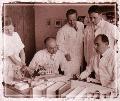
DMT-Nexus member
Posts: 830 Joined: 20-Jan-2009 Last visit: 07-Jun-2017
|
Found this on another forum, I know 69ron will be interested. BRUHN Jan G. (1) ; EL-SEEDI Hesham R. (2) ; STEPHANSON Nikolai (3) ; BECK Olof (3) ; SHULGIN Alexander T. ; (1) Division of Pharmacognosy, Department of Medicinal Chemistry, Uppsala University, Uppsala, SUEDE (2) Department of Chemistry, Faculty of Science, El-Menoufia University, Shebin El-Kom, EGYPTE (3) Department of Clinical Pharmacology, Karolinska University Hospital, Stockholm, SUEDE -Human interest in psychoactive phenethylamines is known from the use of mescaline-containing cacti and designer drugs such as Ecstasy. From the alkaloid composition of cacti we hypothesized that substances resembling Ecstasy might occur naturally. In this article we show that lophophine, homopiperonylamine and lobivine are new minor constituents of two cactus species, Lophophora williamsii (peyote) and Trichocereus pachanoi (San Pedro). This is the first report of putatively psychoactive phenethylamines besides mescaline in these cacti. A search for further biosynthetic analogues may provide new insights into the structure-activity relationships of mescaline. An intriguing question is whether the new natural compounds can be called "designer drugs. Journal of psychoactive drugs ISSN 0279-1072 CODEN JPDRD3 2008, vol. 40, no2, pp. 219-222 You lock the door, and throw away the key
There's someone in my head but it's not me
|
|
|
|
|

DMT-Nexus member
Posts: 5826 Joined: 09-Jun-2008 Last visit: 08-Sep-2010 Location: USA
|
I'm quite interested for sure. But I'm also LMAO at these statements: "In this article we show that lophophine, homopiperonylamine and lobivine are new minor constituents of two cactus species", "An intriguing question is whether the new natural compounds can be called "designer drugs." WTF! They are not NEW! They are millions of years old!  You may remember me as 69Ron. I was suspended years ago for selling bunk products under false pretenses. I try to sneak back from time to time under different names, but unfortunately, the moderators of the DMT-Nexus are infinitely smarter than I am.
If you see me at the waterpark, please say hello. I'll be the delusional 50 something in the American flag Speedo, oiling up his monster guns while responding to imaginary requests for selfies from invisible teenage girls.
|
|
|

DMT-Nexus member
 
Posts: 1139 Joined: 14-Jul-2008 Last visit: 01-Apr-2017 Location: USA
|
I posted about this a while back. Have you actually been able to obtain the article? I was not.
lophophine 2-(7-methoxy-1,3-benzodioxol-5-yl)ethanamine It is mescaline with a methylene-dioxy-bridge connecting the 4, and 5 oxygen rather than the methoxy groups. This compound is active with similar dose and effects as mescaline.
homopiperonylamine 2-(3,4-Methylenedioxyphenyl)ethylamine. This is the phenethylamine of MDA and is not active. It is likely a precursor in the cacti to various isoquinolines.
Lobivine N,N-dimethyl-3,4-methylenedioxyphenethylamine. This is the N,N dimethyl version of homopiperonylamine. It is unlikely to be very active.
|
|
|

DMT-Nexus member
Posts: 5826 Joined: 09-Jun-2008 Last visit: 08-Sep-2010 Location: USA
|
When you extract mescaline HCl from San Pedro, and then wash away the other alkaloids using acetone, and then 99% IPA, this leaves you pure white mescaline. Now the other alkaloids that are washed off are indeed active. The non-mescaline alkaloids present in the wash cause a numbing effect, and feel similar to harmaline, but are more visual. Their effects peak after about 90 minutes and last about 3 hours. SWIM found that these non-mescaline alkaloids greatly potentiate the effects of LSA about 5-10 times! It seems that one or more of these non-mescaline alkaloids have some sort of MAOI functionality. I would love to know which of the non-mescaline alkaloids in San Pedro are responsible for this effect. It's completely unlike mescaline, more like harmaline, but much more visual. The visuals are unique, unlike anything else SWIM has experienced. You may remember me as 69Ron. I was suspended years ago for selling bunk products under false pretenses. I try to sneak back from time to time under different names, but unfortunately, the moderators of the DMT-Nexus are infinitely smarter than I am.
If you see me at the waterpark, please say hello. I'll be the delusional 50 something in the American flag Speedo, oiling up his monster guns while responding to imaginary requests for selfies from invisible teenage girls.
|
|
|
DMT-Nexus member
Posts: 119 Joined: 02-Nov-2008 Last visit: 29-Jun-2011
|
I have access to the full paper (Or what seems to be the full paper, it's only 4 pages long...)
What are y'alls opinions on the ethics of rehosting it?
A summary of their results:
They discerned 3 alkaloids in L. williamsii and T. pachanoi:
Lophophine at 3.3-5% of mescaline concentration in L. williamsii and 0.23-0.31% of mescaline concentration in T. pachanoi.
-"some psychoactivity in the 150 to 250 milligram range"
3,4-dimethoxyphenethylamine, both species "contain" it
-not psychoactive
3,4-methylenedioxyphenethylamine, both species, "minute amounts"
-reportedly "produces tremor, mild visual and space illusions" at unknown dose
-no pschoactivity noted at 200-300 mg
As for your mystery alkaloids, 69ron, Shulgin and company seem to suggest these aren't them. "The contribution of the three new compounds to the overall pharmacological activity of the peyote and San Pedro cacti is most likely limited, due to the low concentrations found, as well as the relative low activity reported."
|
|
|

The Great Namah
Posts: 3433 Joined: 18-Jan-2008 Last visit: 17-Sep-2020 Location: The place entites go when they smoke allspice
|
Quote:An intriguing question is whether the new natural compounds can be called "designer drugs.
This is not an intriguing question, this is a really stupid question. By definition a natural substance that has been around as long as the plant has cannot be a "designer drug". Damn some people, even those with PhD's, can be REALLY stupid when it comes to anything related to psychoactives. Why, in gods name would they even try to classify a naturally occuring substance as a Designer Drug.....and they're not even sure they are active, only that their chemical structure resembles other known actives...damn...STUPID PEOPLE!!!! The Spice extends life
The Spice expands consciousness
The Spice is vital for space travel
___________________________________________________________________________________________________
Never underestimate the power of STUFF!
I am certifiably insane, as such all posts written by me should be regarded as utter nonsense or attempts to get attention.
I don't know SWIM and personally don't trust him at all. If SWIM is posting, most likely I will not respond...as I said, I don't trust the guy. YOU I trust, but never SWIM.
|
|
|

DMT-Nexus member
 
Posts: 1139 Joined: 14-Jul-2008 Last visit: 01-Apr-2017 Location: USA
|
I think they are just asking if it could be classified as an analogue. It does bring up an interesting question, what if novel compounds are found in plants that are structurally similar to scheduled compounds? I do not think they were trying to say that they should be classified as analogues. It is just interesting question but it may have came off the wrong way as "designer drugs" was not the most intellectual way of putting it.
Just because a compound is not active on its own at low doses does not mean that in combination with other compounds it does not contribute to the pharmacology of the parent mixture. In this way I am not satisfied with their conclusion. These compounds in combination with others may influence the overall activity of the cacti.
Ron what is the dose range of the "other" mystery alkaloids?
|
|
|

DMT-Nexus member
Posts: 5826 Joined: 09-Jun-2008 Last visit: 08-Sep-2010 Location: USA
|
bufoman wrote:Ron what is the dose range of the "other" mystery alkaloids? At 25 mg, SWIM found they were not psychedelic, but definitely active. Very weak, sort of resembled a light THH dose. The taste is horribly bitter and makes the mouth numb. A THH style tingling effect is felt in the body. At 50 mg, SWIM felt some euphoria. It was felt at about 13 minutes and then peaked after about 60 minutes. Tingling in the body was felt, as well as numbness in the mouth. At 75 mg, SWIM felt it within 5 minutes. This included the other effects as well as light stimulation. After about 15 minutes there were some minor facial twitches felt, nothing unpleasant though. It didn't last long, maybe 10 minutes. There was slight numbess in the body that accompanied the tingling sensation. The effects peaked at around 60 minutes and there were obvious visual effects. Things looked slightly animated and wavy. After about 3 hours the euphoria peaked. After 4 hours all effects were gone. It seemed like there were at least two alkaloids at play. One caused euphoria and peaked after 3 hours. The other peaks after about 60 minutes and causes tingling, numbness, and wavy visual effects. You may remember me as 69Ron. I was suspended years ago for selling bunk products under false pretenses. I try to sneak back from time to time under different names, but unfortunately, the moderators of the DMT-Nexus are infinitely smarter than I am.
If you see me at the waterpark, please say hello. I'll be the delusional 50 something in the American flag Speedo, oiling up his monster guns while responding to imaginary requests for selfies from invisible teenage girls.
|
|
|

DMT-Nexus member
 
Posts: 1139 Joined: 14-Jul-2008 Last visit: 01-Apr-2017 Location: USA
|
Thank you that was helpful.
What was the method of ingestion?
|
|
|

DMT-Nexus member
Posts: 5826 Joined: 09-Jun-2008 Last visit: 08-Sep-2010 Location: USA
|
It was taken orally. SWIM let it absorb in the mouth sublingually for about 10 minutes and then swallowed it. That's why it made the mouth numb. The numbness is pretty strong at 75 mg. THH, harmine, and harmaline also make the mouth numb, but the numbness felt distinctly different from the harmala alkaloids. You may remember me as 69Ron. I was suspended years ago for selling bunk products under false pretenses. I try to sneak back from time to time under different names, but unfortunately, the moderators of the DMT-Nexus are infinitely smarter than I am.
If you see me at the waterpark, please say hello. I'll be the delusional 50 something in the American flag Speedo, oiling up his monster guns while responding to imaginary requests for selfies from invisible teenage girls.
|